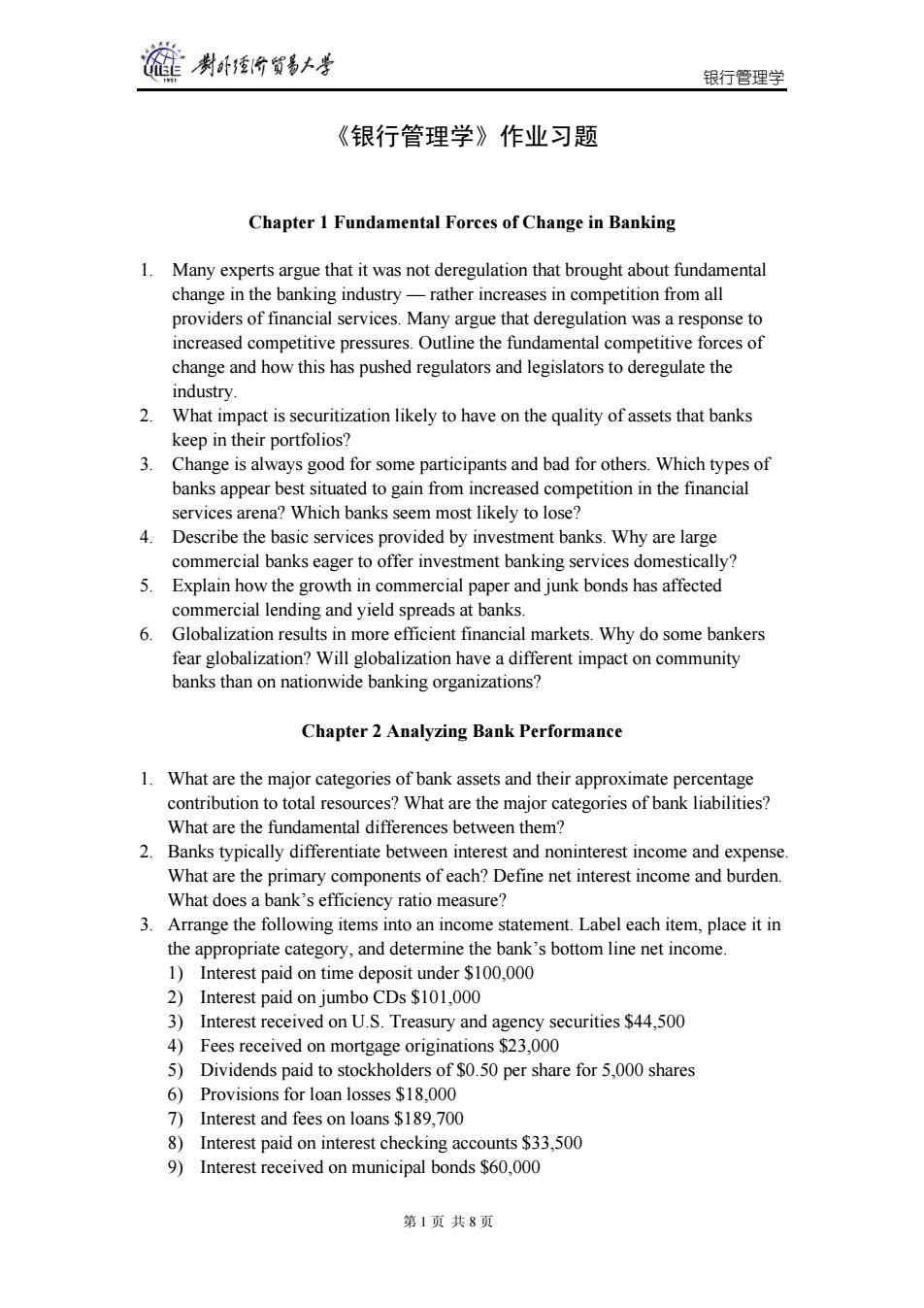正在加载图片...

溢 制卧爱分贸多本芳 银行管理学 《银行管理学》作业习题 Chapter 1 Fundamental Forces of Change in Banking 1.Many experts argue that it was not deregulation that brought about fundamental change in the banking industry-rather increases in competition from all providers of financial services.Many argue that deregulation was a response to increased competitive pressures.Outline the fundamental competitive forces of change and how this has pushed regulators and legislators to deregulate the industry. 2.What impact is securitization likely to have on the quality of assets that banks keep in their portfolios? 3. Change is always good for some participants and bad for others.Which types of banks appear best situated to gain from increased competition in the financial services arena?Which banks seem most likely to lose? 4. Describe the basic services provided by investment banks.Why are large commercial banks eager to offer investment banking services domestically? 5.Explain how the growth in commercial paper and junk bonds has affected commercial lending and yield spreads at banks. 6. Globalization results in more efficient financial markets.Why do some bankers fear globalization?Will globalization have a different impact on community banks than on nationwide banking organizations? Chapter 2 Analyzing Bank Performance 1.What are the major categories of bank assets and their approximate percentage contribution to total resources?What are the major categories of bank liabilities? What are the fundamental differences between them? 2.Banks typically differentiate between interest and noninterest income and expense What are the primary components of each?Define net interest income and burden. What does a bank's efficiency ratio measure? 3.Arrange the following items into an income statement.Label each item,place it in the appropriate category,and determine the bank's bottom line net income. 1)Interest paid on time deposit under $100,000 2)Interest paid on jumbo CDs $101,000 3)Interest received on U.S.Treasury and agency securities $44,500 4)Fees received on mortgage originations $23,000 5)Dividends paid to stockholders of $0.50 per share for 5,000 shares 6)Provisions for loan losses $18,000 7)Interest and fees on loans $189,700 8)Interest paid on interest checking accounts $33,500 9)Interest received on municipal bonds $60,000 第1页共8页银行管理学 第 1 页 共 8 页 《银行管理学》作业习题 Chapter 1 Fundamental Forces of Change in Banking 1. Many experts argue that it was not deregulation that brought about fundamental change in the banking industry — rather increases in competition from all providers of financial services. Many argue that deregulation was a response to increased competitive pressures. Outline the fundamental competitive forces of change and how this has pushed regulators and legislators to deregulate the industry. 2. What impact is securitization likely to have on the quality of assets that banks keep in their portfolios? 3. Change is always good for some participants and bad for others. Which types of banks appear best situated to gain from increased competition in the financial services arena? Which banks seem most likely to lose? 4. Describe the basic services provided by investment banks. Why are large commercial banks eager to offer investment banking services domestically? 5. Explain how the growth in commercial paper and junk bonds has affected commercial lending and yield spreads at banks. 6. Globalization results in more efficient financial markets. Why do some bankers fear globalization? Will globalization have a different impact on community banks than on nationwide banking organizations? Chapter 2 Analyzing Bank Performance 1. What are the major categories of bank assets and their approximate percentage contribution to total resources? What are the major categories of bank liabilities? What are the fundamental differences between them? 2. Banks typically differentiate between interest and noninterest income and expense. What are the primary components of each? Define net interest income and burden. What does a bank’s efficiency ratio measure? 3. Arrange the following items into an income statement. Label each item, place it in the appropriate category, and determine the bank’s bottom line net income. 1) Interest paid on time deposit under $100,000 2) Interest paid on jumbo CDs $101,000 3) Interest received on U.S. Treasury and agency securities $44,500 4) Fees received on mortgage originations $23,000 5) Dividends paid to stockholders of $0.50 per share for 5,000 shares 6) Provisions for loan losses $18,000 7) Interest and fees on loans $189,700 8) Interest paid on interest checking accounts $33,500 9) Interest received on municipal bonds $60,000